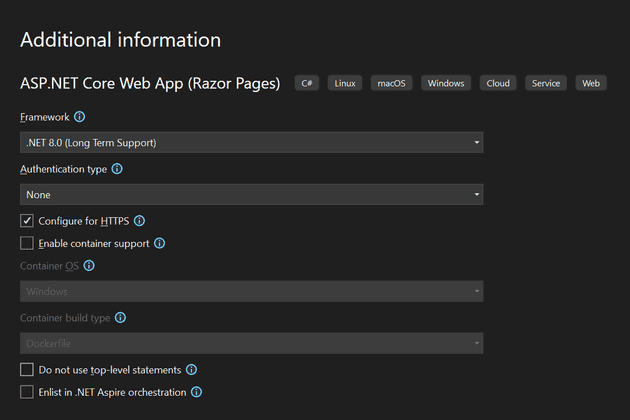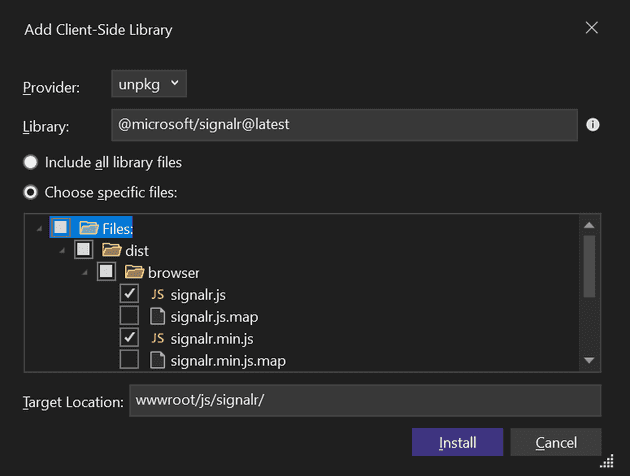Introduction
Recently, I have become fascinated by full-stack development and want to document my learning journey through experimentation with new technologies. I have created a series of guides to demonstrate various technological capabilities using different tools.
We'll start this series with a real-time stock listing platform that updates users on stock prices in real-time and allows live stock discussions via chat. You can download the source code and experiment with it. Any suggestions are always appreciated!
The Stack:
For this project, I am using:
- ASP.NET Core Web API for the back end
- SignalR for real-time events broadcasting
- Hosted Services for background tasks to publish events to the SignalR Hub
I am using ASP.NET Core Web API for my back end as it's the technology I am conformtable with and SignalR for real-time web features, along with hosted services for background tasks to publish events to the SignalR Hub. The app keeps users updated on stock prices in real-time while also allowing them to chat both features utilise SignalR.
Step 1: Create a .NET Core Web App
-
Scaffold a new ASP.NET Core Web App:
- I used Razor Pages, but you can choose your preferred programming model.
Select .NET 8.0 as the framework version:
- At the time of writing, it is the latest and greatest LTS version.
Step 2: Introducing SignalR
-
Install SignalR:
- Download the NuGet package
Microsoft.AspNetCore.SignalR.
- Download the NuGet package
-
Configure SignalR in
Program.cs:`**
builder.Services.AddSignalR();-
Define the Hub:
- Create a hub object inheriting from the base
Hubentity to broadcast changes.
- Create a hub object inheriting from the base
public class LiveChatHub : Hub
{
}-
Configure the Hub in
Program.cs:- This configures the SignalR service to broadcast changes through a pub-sub model.
app.MapHub<StockListingHub>("/stocklisting");Step 3: Simulation
-
Create an Interface:
- Define methods to start and stop the stock generation
public interface IRealTimeStockProvider
{
void Start();
void Stop();
}-
Implement the Interface:
- Generate random dummy data periodically
public class FakeRealTimeStockProvider : IRealTimeStockProvider
{
private readonly IHubContext<StockListingHub> _stockListingHub;
private readonly ILogger<FakeRealTimeStockProvider> _logger;
private Timer? _timer;
public FakeRealTimeStockProvider(IHubContext<StockListingHub> stockHub, ILogger<FakeRealTimeStockProvider> logger)
{
_stockListingHub = stockHub;
_logger = logger;
}
public void Start()
{
_logger.LogInformation("RealTimeStockProvider started.");
_timer = new Timer(async _ => await PostStocks(), null, TimeSpan.Zero, TimeSpan.FromSeconds(1));
}
public void Stop()
{
DisposeTimer();
_timer?.Change(Timeout.Infinite, 0);
_logger.LogInformation("RealTimeStockProvider stopped.");
}
private void DisposeTimer()
{
_timer?.Change(Timeout.Infinite, 0);
_timer?.Dispose();
_timer = null;
}
private async Task PostStocks()
{
decimal price = new Random().Next(101, 113);
_logger.LogInformation($"Posting stock price: {price}");
await _stockListingHub.Clients.All.SendAsync("PostStocks", "PostStocks", price);
}
}-
Create a Hosted Service:
- Registers the IRealTimeStockProvider service with the concrete type FakeRealTimeStockProvider
builder.Services.AddSingleton<IRealTimeStockProvider,FakeRealTimeStockProvider>();- Call the methods from the interface to start and stop stock generation.
public class StockPriceHostedService : IHostedService
{
private readonly IRealTimeStockProvider _realTimeStockProvider;
public StockPriceHostedService(IRealTimeStockProvider realTimeStockProvider)
{
_realTimeStockProvider = realTimeStockProvider;
}
public Task StartAsync(CancellationToken cancellationToken)
{
_realTimeStockProvider.Start();
return Task.CompletedTask;
}
public Task StopAsync(CancellationToken cancellationToken)
{
_realTimeStockProvider.Stop();
return Task.CompletedTask;
}
}- Configure the Hosted Service in
Program.cs:
builder.Services.AddHostedService<StockPriceHostedService>();Step 4: Install SignalR client side library:
- In Solution Explorer, right-click the project and select Add > Client-Side Library. In the Add Client-Side Library dialog, choose "unpkg" as the Provider, enter "@microsoft/signalr@latest" for the Library, and select "Choose specific files." Expand the "dist/browser" folder and select "signalr.js" and "signalr.min.js." Set the Target Location to "wwwroot/js/signalr/" and click Install.
Step 5: Stock Listing User Interface
-
Create
stock.js:- Place the file inside the
wwwroot/jsfolder.
- Place the file inside the
"use strict";
const ctx = document.getElementById('stockChart').getContext('2d');
// Define the data structure for the stock chart.
const stockData = {
labels: [],
datasets: [{
label: 'Stock Price',
data: [],
borderColor: 'rgba(20, 150, 150)',
borderWidth: 1,
fill: true
}]
};
// Create a new line chart using Chart.js
const stockChart = new Chart(ctx, {
type: 'line',
data: stockData,
options: {
scales: {
x: {
type: 'time',
time: {
unit: 'second'
}
},
y: {
beginAtZero: false
}
}
}
});
// Establish a SignalR connection
const stockconnection = new signalR.HubConnectionBuilder()
.withUrl("/stocklisting")
.build();
stockconnection.on("PostStocks", (name, price) => {
const now = new Date();
stockData.labels.push(now);
stockData.datasets[0].data.push(price);
stockChart.update();
});
// Start the SignalR connection
stockconnection.start().catch(err => console.error(err.toString()));
- Create the HTML for the Stock Listing:
@page
<!DOCTYPE html>
<html>
<head>
<title>Real-time Stock Prices</title>
<link href="~/lib/bootstrap/dist/css/bootstrap.min.css" rel="stylesheet" />
<style>
#messagesList {
height: 300px;
overflow-y: auto;
border: 1px solid #ccc;
padding:5px;
}
.chat-box {
margin:10px;
overflow-y: auto;
background-color: #f8f9fa;
}
</style>
</head>
<body>
<div class="container">
<div class="row">
<div class="col-md-8">
<h1>Real-time Stock Prices</h1>
<canvas id="stockChart" width="400" height="200"></canvas>
</div>
</div>
</body>
</html>
<script src="~/js/stock.js"></script>Step 5: Live Chat App User Interface
- Define the LiveChatHub:
public class LiveChatHub : Hub
{
public async Task SendMessage(string user, string message)
{
await Clients.All.SendAsync("ReceiveMessage", user, message);
}
}
- Configure the Hub in
Program.cs:
app.MapHub<LiveChatHub>("/livechat");- Create
chat.js:
"use strict";
var connection = new signalR.HubConnectionBuilder().withUrl("/livechat").build();
// Disable the send button until the connection is established.
document.getElementById("sendButton").disabled = true;
// Define an event handler for the 'ReceiveMessage' event.
connection.on("ReceiveMessage", function (user, message) {
var li = document.createElement("li");
document.getElementById("messagesList").appendChild(li);
var now = new Date();
var timeString = now.toLocaleTimeString([], { hour: '2-digit', minute: '2-digit' });
li.textContent = `[${timeString}] ${user} says: ${message}`;
scrollToBottom();
});
// Start the SignalR connection and enable the send button once connected.
connection.start().then(function () {
document.getElementById("sendButton").disabled = false;
}).catch(function (err) {
return console.error(err.toString());
});
// Add an event listener to the send button to send a message when clicked.
document.getElementById("sendButton").addEventListener("click", function (event) {
var user = document.getElementById("userInput").value;
var message = document.getElementById("messageInput").value;
connection.invoke("SendMessage", user, message).catch(function (err) {
return console.error(err.toString());
});
event.preventDefault();
});
// Scroll to the bottom of the chat when a new message is added.
function scrollToBottom() {
var messagesList = document.getElementById("messagesList");
var isScrolledToBottom = messagesList.scrollHeight - messagesList.clientHeight <= messagesList.scrollTop + 1;
if (isScrolledToBottom) {
messagesList.scrollTop = messagesList.scrollHeight - messagesList.clientHeight;
}
}
- Amend the following html mark up beside the stock listing mark up
<div class="col-md-4">
<h1>Live Chat</h1>
<div class="container-fluid bg-light p-3 rounded">
<div class="mb-3">
<label for="userInput" class="form-label">User</label>
<input type="text" id="userInput" class="form-control" />
</div>
<div class="mb-3">
<label for="messageInput" class="form-label">Message</label>
<input type="text" id="messageInput" class="form-control" />
</div>
<div class="text-end mb-3">
<input type="button" id="sendButton" value="Send" class="btn btn-primary" />
</div>
<div class="mb-3">
<hr />
</div>
<div class="chat-box mb-3">
<ul id="messagesList" class="list-unstyled"></ul>
</div>
</div>
</div>- The final result look like this:
@page
<!DOCTYPE html>
<html>
<head>
<title>Real-time Stock Prices</title>
<link href="~/lib/bootstrap/dist/css/bootstrap.min.css" rel="stylesheet" />
<style>
#messagesList {
height: 300px;
overflow-y: auto;
border: 1px solid #ccc;
padding:5px;
}
.chat-box {
margin:10px;
overflow-y: auto;
background-color: #f8f9fa;
}
</style>
</head>
<body>
<div class="container">
<div class="row">
<div class="col-md-8">
<h1>Real-time Stock Prices</h1>
<canvas id="stockChart" width="400" height="200"></canvas>
</div>
<div class="col-md-4">
<h1>Live Chat</h1>
<div class="container-fluid bg-light p-3 rounded">
<div class="mb-3">
<label for="userInput" class="form-label">User</label>
<input type="text" id="userInput" class="form-control" />
</div>
<div class="mb-3">
<label for="messageInput" class="form-label">Message</label>
<input type="text" id="messageInput" class="form-control" />
</div>
<div class="text-end mb-3">
<input type="button" id="sendButton" value="Send" class="btn btn-primary" />
</div>
<div class="mb-3">
<hr />
</div>
<div class="chat-box mb-3">
<ul id="messagesList" class="list-unstyled"></ul>
</div>
</div>
</div>
</div>
</div>
<script src="https://cdn.jsdelivr.net/npm/chart.js@4.2.1/dist/chart.umd.min.js"></script>
<script src="https://cdn.jsdelivr.net/npm/date-fns"></script>
<script src="https://cdn.jsdelivr.net/npm/chartjs-adapter-date-fns"></script>
<script src="https://cdnjs.cloudflare.com/ajax/libs/microsoft-signalr/5.0.11/signalr.min.js"></script>
<script src="~/js/signalr/dist/browser/signalr.js"></script>
<script src="~/js/chat.js"></script>
<script src="~/js/stock.js"></script>
</body>
</html>
Step 6: Running the App
-
Start the App:
- Simply run the app like you normal would using your preferred method (run into Visual Studio or the
dotnet runcommand).
- Simply run the app like you normal would using your preferred method (run into Visual Studio or the
-
Open the App:
- In your web browser, navigate to the app's URL.
-
Test the Features:
Conclusion
This guide provides a high-level overview of creating a real-time chat and stock listing application using ASP.NET Core's SignalR for real-time features and hosted services for background tasks. I hope this tutorial helps you understand the basics of implementing real-time web applications. Happy coding!



